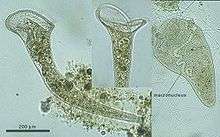Heterotrich
| Heterotrichs | |
|---|---|
 | |
| Stentor roeseli | |
| Scientific classification | |
| Domain: | Eukaryota |
| (unranked): | SAR |
| (unranked): | Alveolata |
| Phylum: | Ciliophora |
| Class: | Heterotrichea Stein 1859 |
| Typical orders | |
|
Heterotrichida | |
The heterotrichs are a class of ciliates. They typically have a prominent adoral zone of membranelles circling the mouth, used in locomotion and feeding, and shorter cilia on the rest of the body. Many species are highly contractile, and are typically compressed or conical in form.[1] These include some of the largest protozoa, such as Stentor and Spirostomum, as well as many brightly pigmented forms, such as certain Blepharisma.
A number of ultrastructural details characterize the group. The cilia on the body are in dikinetids, in which either the anterior one or both kinetosomes may be ciliated, and which are associated with fibers composed of overlapping postciliary microtubules, called postciliodesmata and found only in this group and the closely related Karyorelictea. A series of oral polykinetids, each containing two or three rows of kinetosomes, support the membranelles. These run from the left to the anterior of the mouth, and often spiral out of the oral cavity. The macronucleus is divided by external microtubules, whereas in the Karyorelictea it forms by differentiation of micronuclei, and in all other ciliates it is divided by internal microtubules.
Traditionally the heterotrichs have been treated as a subgroup of spirotrichs, but more recent work has found that they are not closely related to the other groups placed there, and accordingly they tend to be given their own class. Most belong to the order Heterotrichida; the position of the other orders is not clear, and Lynn has suggested that they do not really belong here, tentatively returning some to the Spirotrichea and treating others as a new class (Armophorea).
References
- ↑ Lobban CS, Schefter M. (2016). An Integrated Model of the Biology of the Marine Symbiosis Maristentor dinoferus. In: Witzany, G, Nowacki, M. (eds). Biocommunication of Ciliates, Springer, pp. 305-326..
- Shazib SU, Vďačný P, Kim JH, Jang SW, Shin MK (May 2014). "Phylogenetic relationships of the ciliate class Heterotrichea (Protista, Ciliophora, Postciliodesmatophora) inferred from multiple molecular markers and multifaceted analysis strategy". Mol. Phylogenet. Evol. 78C: 118–135. doi:10.1016/j.ympev.2014.05.012. PMID 24859684.
- "Heterotrichea". NCBI Taxonomy Browser. 194287.